| Azulito (little blue one)
is a Sam Devlin
Designing Boatbuilders Polliwog
design V bottom 7ft, 6-inch dinghy that I built,
with some excellent assistance from 13-year-old family
friend Dan Van Deusen in my small basement shop.
Azulito is built of plywood, using
the stitch and glue method. It is epoxy sealed,
with glass cloth on the bottom, as specified in the
Devlin plans.
The plans do not provide for a sailing
rig, but the Devlin Design Guppy
does and I chose to make a sailing rig for my Polliwog.
The Guppy is a 9ft 6inch boat, very similar to the Polliwog.
I made a daggerboard that was similar to the one in
the Guppy. It fits under a seat that runs from
the bow to approximately amidships along the centerline.
For rowing, the seat arrangement allows the rower to
trim the boat properly by adjusting the sitting position
a bit forward or aft.
The Guppy design specifies a cut down
windsurfer sailing rig. I made an alternate
choice for Azulito for two reasons. First, the
windsurfer mast and sails that I saw, cost something
on the order of $500, way over the budget I had in mind.
Secondly, I wanted something that I could easily stow
in the boat if I decided to switch from sailing to rowing
while underway. Winds in local lakes can be inconsistent.
The rig I chose was designed
as a temporary sailing conversion for a pram type dinghy
from an article
I found on Gavin Atkin’s Free
Boat Design Resources web site. According
to the article, “The magical thing about this rig is
that if you let fly the tack line the whole contrivance
up-ends and dissolves into a mass of floppy folds so
that if a hard squall descends one can just jerk the
line and duck”. I was less concerned about
squalls in our area than having the wind totally die
in the summer and I did not want to start trying to
row with a sail thrashing around. Of course, the
appearance of the article on the site is a quote. The
article is quoted from “The A-Z of cheaper boating'
by Bill Beavis, publisher Stanley Paul, London 1977”
and the book author credited the idea to “Des Sleightholme,
editor of Yachting Monthly.” So the rig design
was not exactly meant for my boat, but I had at least
3 respectable sources implying that the rig was not
a bad idea for a dinghy.
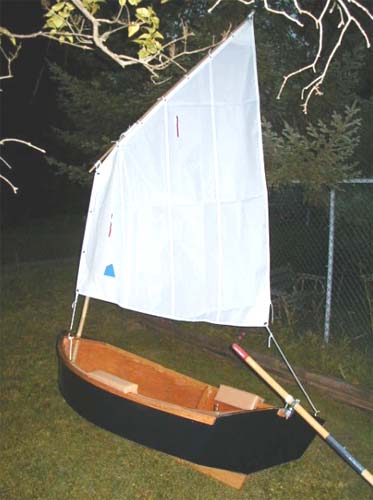
I did not use the leeboard, having
a daggerboard instead, similar to the Guppy. Instead
of using a wooden mast and a bamboo yard, I got a larger
diameter piece of bamboo for the mast (it worked, with
no flexing) and a bamboo yard as specified. It
was easy to epoxy a little dowel in the top of the mast
to hold the yard becket. (I suspect I am not the
only person who did not know what a “yard becket” is
before I read the article). I liked the idea of
using bamboo as a cheap alternative to craftsman-built
or commercially available hollow spars. I chose
to ignore the “looks like some sort of contraption from
Gilligan’s Island” remarks that resulted.
The other modification of the sail
rig was a matter of personal courage, or rather, a lack
of courage. I reasoned that the rig was designed
for an 8 foot or larger pram, and my boat was to be
pointy bowed, a little shorter, and perhaps less beamy.
I do enjoy swimming, but I like to keep my sailing and
my swimming as totally separate activities, so I asked
my sailmaker, Paul J Heyse of Ulta Sail, to reduce the
size of the sail in the design. He made one up for me
at a very reasonable price in Dacron.
The conversion rig’s design also called
for a steering oar rather than a rudder. This
fit nicely with my idea of switching from sailing to
rowing on the water. The oar had to be there anyhow
and I did not want another piece to get in the way on
a tiny boat. Besides, with an oar for a rudder,
I wouldn’t have to make a rudder. I bought a pair
of commercially made oars that come apart into two pieces.
The oar that is not being used for steering comes apart
and fits nicely next to the seat.
Besides staying dry while sailing,
I wanted to be comfortable, so I made some L shaped
padded boards that fit over the shear clamps, with dowels
that fit into the oarlock sockets. The pad on
one side was to be for my back, the other for my extended
legs. My bottom was to fit on the boat’s bottom
with a flotation cushion for padding. It was sort
of a reclining TV chair arrangement. In fact,
I did sail the boat in that position; I was glad to
keep my center of gravity low and my legs extended rather
than scrunched. Dan is smaller and more agile
at 13 than I am at 55, so he chose to sit in the bottom
center on the cushion with his legs curled.
There is no boom, so I wanted to get
the mainsheet as far back on the boat as I could.
I put little open hooks, single prong clothes hooks,
really, on each of the quarter knees. You have
to move the line when tacking.
The project
was pretty straightforward, but it took forever when
measured on a calendar, with me usually working in short
spurts of stolen time, often only a few minutes in a
session. Dan was a significant contributor, working
for a most of a weekend on the boat.
The oak
inner and outer shear clamps on Azulito did require
steam bending. I had met Geoff McKonly and other nice
folks at
The Philadelphia Wooden Boat Factory a non-profit
educational facility, while I was visiting Philadelphia.
One night they let me audit a class in steam bending,
a session from a full boatbuilding course offered periodically.
Back home in upstate NY, I used a length of plastic
drainpipe as my steam chamber, hooked up with a hose
to a teakettle. The ideal wood for bending is
somewhat green. I got my oak pieces when I bought
a factory new pickup truck, to make stakes to extend
the box sides. I bought a cap instead and had
never made stakes. Since the pickup was a 1977
model, I had missed the green wood specification by
a huge margin, but the wood bent nicely anyhow.
We were pleased with the results
under oar and sail at the launching on September 9,
2002, at Great Sacandaga Lake, a large man-made lake
in NY State’s southern Adirondack Mountain region. We
celebrated the launch with a douse of sparkling grape
juice on the bow and sent the boat off from a dock under
oar power with Dan in command. It worked just fine.
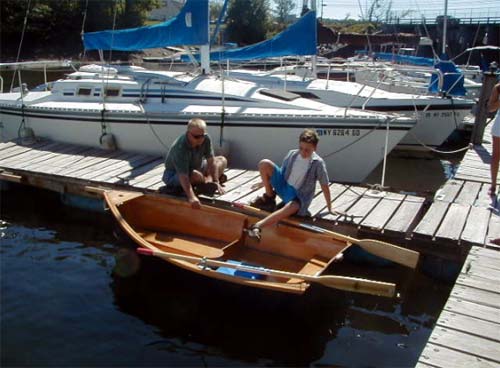
Dan’s Dad, Dave, gave an assist at
rowing launch time

Despite limited rowing experience,
Dan rowed Azulito like a veteran waterman to a dock
that was closer to open water for the sail launching.

The families present agreed that I
was more expendable in case something unseemly happened
during the sail launch, so I took the helm next.
Dan released the boat from the dock, while his Dad,
Dave, acted as official photographer.
Dan took over later, after we had
established that the boat was not going to sink immediately
under sail. Dan had a little sailing experience
previously but he had practiced in reverse of the traditional
sequence. First, a couple years ago, he had tried
the helm on our 26 foot fiberglass sloop, doing an excellent
job despite being still young enough to have trouble
seeing over the cabin. Later, he spent a fair
portion of an afternoon sailing a more kid-sized Bolger
Tortoise that I had built and named Amy’s Giggle, after
a sister of Dan’s with an infectious laugh.
That was Dan’s entire sailing resume
before the Azulito launch, but he also had spent some
time paddling a Jim
Michalak designed Quark that I had built and
named “wine quark” for its color. The Quark
is a minimal 1 sheet plywood double paddle canoe intended
for short shallow water and harbor jaunts, but with
Dan’s natural skill and light weight, it became a proper
exploration vehicle. Dan used it on a family camping
trip at Rollins Pond state campsite in the Adirondacks
and day-cruised through protected waters in company
with others in conventional canoes. We added improvised
flotation to the hull, just in case. Dan’s
Quark weighs 22 lbs, perhaps a little heavier than it
needed to be because of too much filler for finishing,
but he could portage it alone.
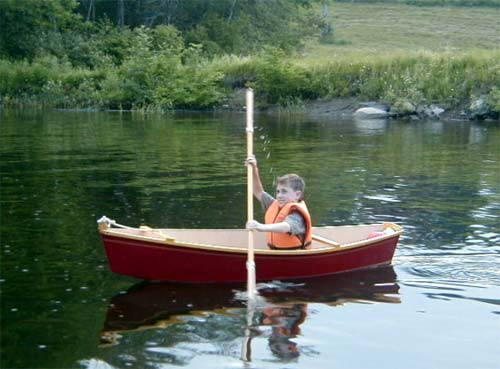
Dan and the Wine Quark
Azulito’s launch day was warm and
clear, with a wind of 7-10 MPH average and an occasional
stronger gust. Dan and I both had difficulty getting
familiar with the steering oar, but only initially.
The boat steered and came about easily and the hook
arrangement for the mainsheet seemed to be a good solution.
Occasionally, we could reduce drag by pulling the steering
oar out of the water when we got the sail/wind and daggerboard
all in balance. It was also easy to use the steering
oar more like an oar to force the boat through a less
than ideal tack maneuver where a rudder might not have
worked as well. Dan took a couple deep breaths
when the first powerboat wakes and wind gusts came,
but he soon learned to trust the boat. The boat
and helmsman never seemed in danger of being overwhelmed
and Dan was completely in control. The rest of
us watched from the 26 footer.
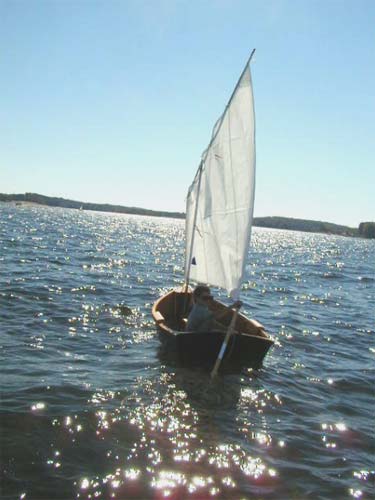
Don’t blame Dan for the odd sunglasses
in the photo. These are loaners from a mesh bag
in the cockpit of the 26 footer. We chose them
as the most unlikely sunglasses to ever be stolen and
so far have been proven right. A more likely end
for the glasses is that someone will eventually throw
them in the drink as a sort of mercy gesture.
The launch was a success, but of course,
there were a few problems. I have not weighed
the boat; it is perhaps 60 lbs. My wife, Carol,
had previously contributed to the boat project only
by helping me liberate corks from wine bottles and being
extremely patient while I ignored more important things
to work on the boat. The corks were used as plugs
for the floatation chambers (there are two of them)
for inspection and to drain water in case of condensation
or leakage. No fit alternative helpers were around,
so she had to help me load the boat on our tallish Jeep
Cherokee, after helping me get the boat out of the basement
shop, the basement having far too many stair steps.
She has some knee and muscle problems, so stairs are
hard for her even without boats to carry. This
did not improve marital harmony for me. Future
boats will probably be lighter, or the kind that come
in two parts that you can bolt together. If I
can’t carry it myself, I probably shouldn’t build it.
Our Jeep Cherokee is a sort of anachronism
in a way I like. It has old-fashioned roof gutters,
the kind that work perfectly with the old-fashioned
gutter clamps on my aftermarket roof racks. You
can get racks that work nicely without gutters, of course,
but they often depend on pads resting on the sheet metal,
where bits of grit against the paint and oilcan flexing
are potential enemies. Aerodynamic factory racks
are a bit slippery without accessories and, in the case
of my factory racks and Azulito, too low to clear some
protrusions from the boat and the arc in its shear line.
The current Jeep Liberty model, sadly, has no gutters.
The only problem with the way I used
the racks was that the hold down straps wanted to slip
dangerously close to the edge of the keel and I was
afraid they would slip off. It didn’t happen,
but I plan to make an oblong hole in the keel as a handhold
for manipulating the boat while carrying it and as a
place to route the straps.
I made two mistakes with the sailing
rig. First, before the launch, I did not have
the downhaul line at the sail tack tight enough, and
so the standing lug peak sagged a bit. I fixed
this before Dan sailed. Worse, I did not secure
the sail to the yard well enough. The lashed top
attachment (I did not want to put potentially weakening
holes in my bamboo) slid down the yard a little, interfering
with sail shape. The bits of line holding the
sail to the yard through two grommets near the yard
midpoint came loose during Dan’s sail, further degrading
the sail shape. I’ll do better for the next
trip, if there is a next trip. We have established that
the next trip will not involve my wife in boat lugging
chores.
The way I fastened the oar to the
stern for steering used clamped-on oarlocks that are
fastened tightly to the oars. The transom has an oarlock
socket. This worked and there were no unattached
pieces to lose, but it precluded using the steering
oar for sculling. As long is the oar is back there
anyhow, I probably should have opted for oar leathers
or a sculling slot in the transom that would let me
twist the oar for sculling.
Building Azulito was great fun for
me. I would be glad to try to answer any
questions a would-be builder of this type of boat might
have via email,
psmullens@yahoo.com. I am an admitted
pure amateur, of course, so any answers might be suspect,
but I could at least know that I would then not be alone
in my misconceptions.
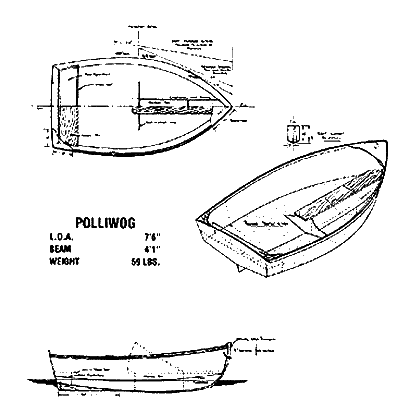
|

